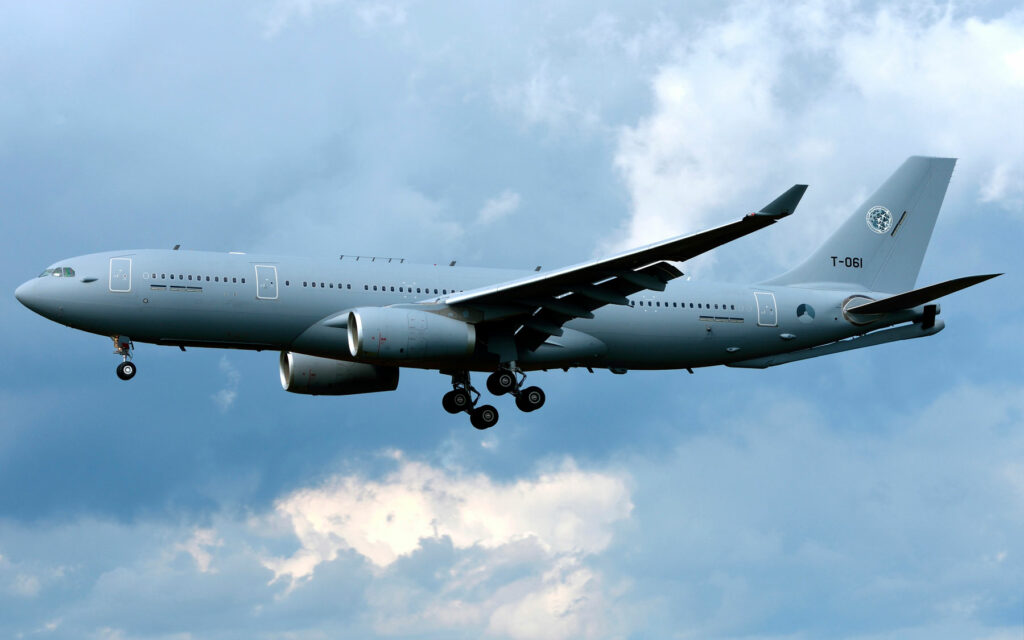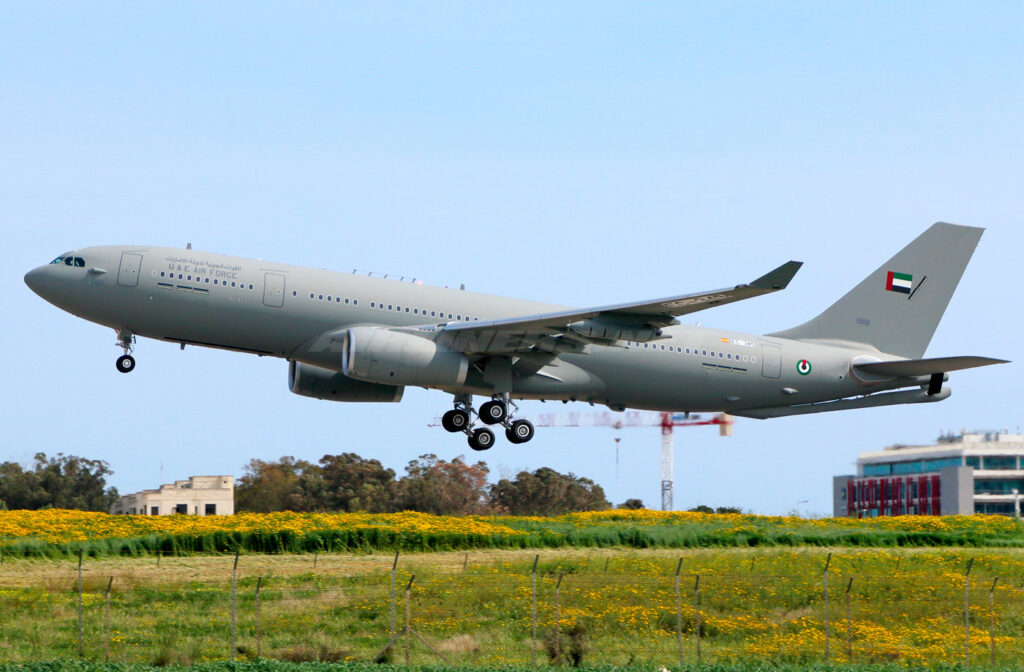The Airbus A330 MRTT: A strategic, long-range multi-role tanker transport for aerial refueling and military support.
In brief
The Airbus A330 MRTT (Multi-Role Tanker Transport) is a versatile military aircraft derived from the A330-200 commercial airliner. This platform is engineered for in-flight refueling, personnel, cargo transport, and aeromedical evacuation. Designed with advanced avionics and an extended range, the A330 MRTT provides significant operational flexibility. It incorporates a high-capacity refueling boom system, Cobham 905E under-wing refueling pods, and a Universal Aerial Refueling Receptacle Slipway Installation (UARRSI) for receiver capability, allowing mid-air refueling with other tankers. It offers up to 245,000 pounds (111,000 kg) of fuel, removing the need for additional fuel bladders. Equipped with either General Electric CF6-80E1A3 or Rolls-Royce Trent 772B engines, the A330 MRTT can reach a maximum range of 8,000 nautical miles (14,800 km) and cruise at Mach 0.86. The aircraft serves in multiple air forces, including those of Australia, the United Kingdom, and Saudi Arabia, and is highly adaptable to various mission profiles.

The Airbus A330 MRTT
The Airbus A330 MRTT originated as a response to the global need for advanced aerial refueling and logistics capabilities. Military demands for versatile and efficient transport aircraft led Airbus to adapt the successful A330-200 commercial airliner, modifying it to suit combat and refueling missions. Initiated by Airbus Defence and Space, the A330 MRTT program offered NATO and allied forces a cost-effective solution with a significant fuel capacity and extended operational range. Since its first delivery in 2011, the A330 MRTT has become integral to modern air forces, supporting long-distance refueling, troop deployment, and aeromedical evacuation. With orders from over 15 countries, the aircraft has replaced older models and serves as the strategic backbone for air mobility and support across NATO operations and allied missions worldwide.
History of Development
The A330 MRTT project began in response to a NATO and allied forces’ need for an enhanced air tanker capable of long-range refueling and strategic transport. By the late 1990s, existing tanker models, including the KC-135 and KC-10, faced rising operational costs and performance limitations. In 2004, Airbus launched the A330 MRTT program to deliver a high-capacity, efficient tanker that utilized Airbus’s proven A330-200 as its foundation. Airbus made strategic design changes to meet NATO and international defense standards, adding aerial refueling systems, reinforced structures, and advanced avionics.
Airbus initially proposed the A330 MRTT for the U.S. Air Force’s KC-X program, intended to replace the KC-135 fleet. Partnering with Northrop Grumman, Airbus offered the KC-30, an A330 MRTT variant tailored to U.S. requirements. Although the partnership was not successful due to competition with Boeing’s KC-46A, Airbus’s aircraft garnered attention and orders from international air forces. By 2008, the A330 MRTT was selected by the Royal Australian Air Force (RAAF) as the KC-30A, making Australia the launch customer. Delivery delays initially impacted the program due to challenges with boom technology, but by 2011, the RAAF received its first KC-30A. Other air forces quickly followed suit, recognizing the A330 MRTT’s refueling capacity, range, and multi-role flexibility.
With this platform, Airbus Defense introduced critical advancements, including the Boom Enhanced Vision System (BEVS), allowing the boom operator to perform refueling remotely through a high-definition 3D camera interface. This innovation enabled safer and more efficient refueling operations, even in challenging conditions. In addition, the MRTT’s ability to conduct both probe-and-drogue and boom refueling made it compatible with NATO allies’ diverse aircraft types. Airbus later upgraded the A330 MRTT to enhance fuel efficiency by integrating aerodynamic improvements and structural modifications, with new versions achieving fuel-burn reductions of about 1%.
Design
The A330 MRTT’s design includes a widebody airframe adapted from the A330-200, optimized for refueling and transport. Its maximum takeoff weight is 514,000 pounds (233,000 kg), with structural modifications to support the refueling boom system and optional under-wing pods. The wingspan measures 198 feet (60.3 meters), providing stability at refueling altitudes and accommodating the under-wing pods. The aircraft is powered by either the General Electric CF6-80E1A3 or Rolls-Royce Trent 772B engines, offering a balance of power, range, and fuel efficiency.
The cabin layout supports multi-role flexibility, carrying up to 270 passengers and 34,000 kg of cargo on dedicated missions or equipped for aeromedical evacuation. Its cargo deck can accommodate a variety of palletized loads, expanding logistical options for deploying forces. The MRTT’s glass cockpit, with side-stick controllers, simplifies flight management for a crew of two. The fly-by-wire control system allows precision control, essential for maintaining stability during refueling operations. The onboard fuel tanks hold 245,000 pounds (111,000 kg) without additional bladders, enabling dual capabilities for fuel transfer and cargo or personnel transport.
Performance
With engines rated at 60,000 to 72,000 pounds of thrust, the A330 MRTT achieves a top cruising speed of Mach 0.86 and a maximum ferry range of 8,000 nautical miles (14,800 km), which is competitive for long-range missions. This performance makes it one of the fastest and farthest-reaching tanker transports, well-suited for refueling fighters or strategic bombers over transcontinental ranges. The refueling boom, capable of delivering fuel at 1,200 gallons per minute, allows for rapid refueling of large aircraft, while the probe-and-drogue system supports smaller fighters and helicopters.
The A330 MRTT’s long-range and refueling capabilities exceed many competing tankers, such as Boeing’s KC-46, which has a lower fuel capacity. Its twin-engine configuration contributes to cost efficiency, particularly for long-duration flights. The aircraft’s Defensive Aid System (DAS), which includes infrared countermeasures and missile warning systems, enhances survivability in hostile environments, making it suitable for frontline operations.
Variants
The A330 MRTT’s variants are tailored to meet diverse operational needs. The primary version, known as the “standard” MRTT, includes dual refueling methods. The KC-30A variant, used by the Royal Australian Air Force, has additional onboard communication and sensor packages to support RAAF missions. Another version, used by the United Kingdom’s Royal Air Force, is designated as the Voyager MRTT and supports the UK’s air mobility and refueling requirements. The new MRTT+ variant, unveiled in 2024, is based on the A330neo with enhanced fuel efficiency and upgraded engines.

Military Use and Combat
The A330 MRTT has proven its value in military operations, with roles in combat and logistics. The Royal Air Force employed the Voyager MRTT in air-to-air refueling for NATO’s Baltic Air Policing, extending fighter endurance over Europe. Australia’s KC-30A supported operations in the Middle East, refueling F/A-18 Hornets and B-1 bombers during anti-ISIS missions. In Asia, Singapore’s A330 MRTTs strengthen defense partnerships by supporting refueling and troop transport missions across the region.
With advanced fuel delivery systems, the A330 MRTT can support multiple aircraft types simultaneously. It has participated in large-scale NATO exercises, enabling flexible refueling for various combat and reconnaissance missions. The MRTT’s wide adoption has facilitated international interoperability, with air forces like those of Saudi Arabia and South Korea deploying it in strategic and defensive roles.
The platform’s flexibility and capacity for real-time operational support make it an asset in international military collaborations, and its role is set to expand as more nations invest in MRTT variants for modern defense needs.
Back to the Special Aircraft section